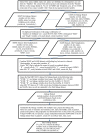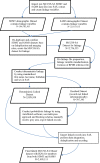Describing the linkage between administrative social assistance and health care databases in Ontario, Canada
- PMID: 35310557
- PMCID: PMC8900651
- DOI: 10.23889/ijpds.v6i1.1689
Describing the linkage between administrative social assistance and health care databases in Ontario, Canada
Abstract
Background: The linkage of records across administrative databases has become a powerful tool to increase information available to undertake research and analytics in a privacy protective manner.
Objective: The objective of this paper was to describe the data integration strategy used to link the Ontario Ministry of Children, Community and Social Services (MCCSS)-Social Assistance (SA) database with administrative health care data.
Methods: Deterministic and probabilistic linkage methods were used to link the MCCSS-SA database (2003-2016) to the Registered Persons Database, a population registry containing data on all individuals issued a health card number in Ontario, Canada. Linkage rates were estimated, and the degree of record linkage and representativeness of the dataset were evaluated by comparing socio-demographic characteristics of linked and unlinked records.
Results: There were a total of 2,736,353 unique member IDs in the MCCSS-SA database from the 1st January 2003 to 31st December 2016; 331,238 (12.1%) were unlinked (linkage rate = 87.9%). Despite 16 passes, most record linkages were obtained after 2 deterministic (76.2%) and 14 probabilistic passes (11.7%). Linked and unlinked samples were similar for most socio-demographic characteristics (i.e., sex, age, rural dwelling), except migrant status (non-migrant versus migrant) (standardized difference of 0.52). Linked and unlinked records were also different for SA program-specific characteristics, such as social assistance program, Ontario Works and Ontario Disability Support Program (standardized difference of 0.20 for each), data entry system, Service Delivery Model Technology only and both Service Delivery Model Technology and Social Assistance Management System (standardized difference of 0.53 and 0.52, respectively), and months on social assistance (standardized difference of 0.43).
Conclusions: Additional techniques to account for sub-optimal linkage rates may be required to address potential biases resulting from this data linkage. Nonetheless, the linkage between administrative social assistance and health care data will provide important findings on the social determinants of health.
Keywords: Ontario; administrative health care data; administrative social assistance data; data linkage.
Conflict of interest statement
Conflicts of interest: None to be declared.
Figures



Similar articles
-
Describing the linkages of the immigration, refugees and citizenship Canada permanent resident data and vital statistics death registry to Ontario's administrative health database.BMC Med Inform Decis Mak. 2016 Oct 21;16(1):135. doi: 10.1186/s12911-016-0375-3. BMC Med Inform Decis Mak. 2016. PMID: 27769227 Free PMC article.
-
Use of administrative record linkage to measure medical and social risk factors for early developmental vulnerability in Ontario, Canada.Int J Popul Data Sci. 2021 Feb 11;6(1):1407. doi: 10.23889/ijpds.v6i1.1407. Int J Popul Data Sci. 2021. PMID: 34007902 Free PMC article.
-
Creating a Powerful Platform to Explore Health in a Correctional Population: A Record Linkage Study.PLoS One. 2016 Aug 17;11(8):e0161173. doi: 10.1371/journal.pone.0161173. eCollection 2016. PLoS One. 2016. PMID: 27532612 Free PMC article.
-
Procedures for health data linkage: applications in health surveillance.Epidemiol Serv Saude. 2022 Oct 10;31(3):e20211272. doi: 10.1590/S2237-96222022000300004. eCollection 2022. Epidemiol Serv Saude. 2022. PMID: 36287481 Free PMC article. Review.
-
Record linkage for pharmacoepidemiological studies in cancer patients.Pharmacoepidemiol Drug Saf. 2012 Jan;21(1):94-103. doi: 10.1002/pds.2205. Epub 2011 Aug 2. Pharmacoepidemiol Drug Saf. 2012. PMID: 21812067 Review.
Cited by
-
Young adults with intellectual and developmental disabilities who participate in Special Olympics are less likely to be diagnosed with depression.Soc Psychiatry Psychiatr Epidemiol. 2023 Nov;58(11):1699-1708. doi: 10.1007/s00127-022-02406-8. Epub 2022 Dec 22. Soc Psychiatry Psychiatr Epidemiol. 2023. PMID: 36544012
-
Social care data and its fitness for integrated health and social care service governance: an exploratory qualitative analysis in the Dutch context.BMJ Open. 2024 Apr 25;14(4):e078390. doi: 10.1136/bmjopen-2023-078390. BMJ Open. 2024. PMID: 38670619 Free PMC article.
References
-
- Personal Health Information Protection Act, 2004, S.O. 2004, c. 3, Sched. A. Ontario. 2020. https://www.ontario.ca/laws/statute/04p03 (Accessed 29 April 2021).
-
- de Oliveira C, Cheng J, Rehm J, Kurdyak P. The Economic Burden of Chronic Psychotic Disorders in Ontario. J Ment Health Policy Econ. 2016; 19(4):181–192. - PubMed
-
- Manuel DG, Perez R, Sanmartin C, Taljaard M, Hennessy D, Wilson K, Tanuseputro P, Manson H, Bennett C, Tuna M, Fisher S, Rosella LC. Measuring Burden of Unhealthy Behaviours Using a Multivariable Predictive Approach: Life Expectancy Lost in Canada Attributable to Smoking, Alcohol, Physical Inactivity, and Diet. PLoS Med. 2016; 13(8):e1002082. 10.1371/journal.pmed.1002082. - DOI - PMC - PubMed
Publication types
MeSH terms
LinkOut - more resources
Full Text Sources
